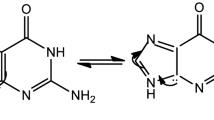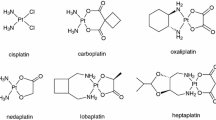Abstract
The novel DOTA-like chelator 1,4,7,10-tetraazacyclododecane-1-{4-[(3-chloro-4-fluorophenyl)amino]quinazoline-6-yl}propionamide-4,7,10-triacetic acid (H3L) was synthesised by alkylation of 1,4,7,10-tetraazacyclododecane-1,4,7-tris(t-butyl acetate) with N-{4-[(3-chloro-4-fluorophenyl)amino]quinazoline-6-yl}-3-bromopropionamide, followed by hydrolysis of the ester groups with trifluoracetic acid. H3L has been fully characterised by multinuclear NMR spectroscopy, mass spectrometry and high-performance liquid chromatography (HPLC). Five protonation constants, log K Hi , of H3L were determined by potentiometry and UV–vis spectrophotometry and the values found are 10.47, 9.18, 5.24, 4.00 and 2.23. These methods, complemented with variable-pH 71Ga NMR studies, allowed us to ascertain the stability constant of the Ga(III) complex of L. GaL has a remarkably high thermodynamic stability constant (log K ML = 24.5). The radioactive complex 67GaL was prepared in high yield and high radiochemical purity. Its HPLC chromatogram is identical to that obtained for the GaL complex prepared at the macroscopic level. At pH 7.4, 67GaL has an overall neutral charge, is highly hydrophilic (log D = −1.02 ± 0.03) and presents high in vitro stability in physiological media and in the presence of an excess of diethylenetriaminepentaethanoic acid . In vitro studies indicated that H3L and GaL do not inhibit the cell growth of epidermal growth factor receptor expressing cell lines, such as A431 cervical carcinoma cells, a result which agrees with the very low cell internalisation found for 67GaL in the same cell line. Biodistribution studies in mice indicated high in vivo stability for 67GaL, a high total excretion rate and a relatively slow blood clearance, in full accordance with its hydrophilic character and the relatively important protein binding.







Similar content being viewed by others
References
Herbst RS (2004) Int J Radiat Oncol Biol Phys 59(2):21–26
Wong RWC, Guillaud L (2004) Cytokine Growth Factor Rev 5:147–156
Mendelsohn J, Baselga J (2003) J Clin Oncol 21(14):2787–2799
Sridhar SS, Seymour L, Shepherd FA (2003) Lancet Oncol 4(7):397–406
Laskin JJ, Sandler AB (2004) Cancer Treat Rev 30:1–17
Cai W, Niu G, Chen X (2008) Eur J Nucl Med Mol Imaging 35:186–208
Yu Z, Boggon TJ, Kobayashi S, Jin C, Ma PC, Dowlati A, Kern JA, Tenen DG, Halmos B (2007) Cancer Res 67(21):10417–10427
Bonasera TA, Ortu G, Rozen Y, Krais R, Freedman NM, Chisin R, Gazit A, Levitzki A, Mishani E (2001) Nucl Med Biol 28:359–374
Dissoki S, Laky D, Mishani E (2006) J Labelled Comp Radiopharm 49:533–543
Johnström P, Fredriksson A, Thorell J-O, Stone-Elander S (1998) J. Labelled Comp Radiopharm 41:623–629
Ben-David I, Rozen Y, Ortu G, Mishani E (2003) Appl Radiat Isot 58:209–217
Mishani E, Abourbeh G, Rozen Y, Jacobson O, Laky D, Ben DI, Levitzki A, Shaul M (2004) Nucl Med Biol 31:469–476
Mishani E, Abourbeh G, Rozen Y, Jacobson O, Dissoki S, Daniel RB, Rozen Y, Shaul M, Levitzki A (2005) J Med Chem 48:5337–5348
Ortu G, Ben-David B, Rozen Y, Freedman NMT, Chisin R, Levitski A, Mishani E (2002) Int J Cancer 101:360–370
Shaul M, Abourbeh G, Jacobson O, Rozen Y, Laky D, Levitzki A, Mishani E (2004) Bioorg Med Chem 12:3421–3429
Mishani E, Abourbeh G (2007) Curr Top Med Chem 7:1755–1772
Breza N, Pató J, Orfi L, Hegymegi-Barakonyi B, Anhegyi PB, Varkondi E, Borbely G, Petak I, Keri G (2008) J Recept Signal Transduct 28(4):361–373
Fernandes C, Oliveira C, Gano L, Bourkoula A, Pirmettis I, Santos I (2007) Bioorg Med Chem 15(12):3974–3980
Fernandes C, Santos IC, Santos I, Pietzsch H-J, Kunstler J-U, Kraus W, Rey A, Margaritis N, Bourkoula A, Chiotellis A, Paravatou-Petsotas M, Pirmettis I (2008) Dalton Trans 3215–3225
Beeby A, Bushby LM, Maffeo D, Williams JAG (2002) J Chem Soc Dalton Trans 48–54
Irving HM, Miles MG, Pettit LD (1967) Anal Chim Acta 38:475
Zékány L, Nagypál I (1985) Computational methods for determination of formation constants. Plenum Press, New York, p 291
Troutner DE, Volkert WA, Hoffman TJ, Holmes RA (1984) Int J Appl Radiat Isot 35:467–470
Martell AE, Smith RM (2003) NIST standard reference database 46 (critically selected stability constants of metal complexes), version 7.0
Burgess J (1978) Metal ions in solution. Harwood, Chichester, p 314
Clarke ET, Martell AE (1991) Inorg Chim Acta 190:37–46
Glickson JD, Pitner TP, Webb J, Gams RA (1975) J Am Chem Soc 97:1679–1683
Akitt JW, Kettle D (1989) Magn Reson Chem 27:377–379
Liu S (2008) Adv Drug Deliv Rev 60:1347–1370
Bandoli G, Dolmella A, Tisato F, Porchia M, Refosco F (2008) Coord Chem Rev. doi:10.1016/j.ccr.2007.12.001
Léon-Rodríguez LM, Kovacs Z (2008) Bioconjug Chem 19(2):391–402
Heppeler A, Froidevaux S, Mäcke HR, Jermann E, Béhé M, Powell P, Hennig M (1999) Chem Eur J 5(7):1974–1981
Tanaka K, Fukase K (2008) Org Biomol Chem 6:815–828 and references therein
Velikyan I, Sundberg AL, Lindhe O, Höglund AU, Eriksson O, Werner E, Carlsson J, Bergström M, Långström B, Tolmachev V (2005) J Nucl Med 46:1881–1888
Schmid M, Neumaier B, Vogg ATJ, Wczasek K, Friesen C, Mottaghy FM, Buck AK, Reske SN (2006) Nucl Med Biol 33:359–366
Zhang H, Schuhmacher J, Waser B, Wild D, Eisenhut M, Reubi JC, Maecke HR (2007) Eur J Nucl Med Mol Imaging 34(8):1198–1208
Mier W, Hoffend J, Krämer S, Schuhmacher J, Hull WE, Eisenhut M, Haberkorn U (2005) Bioconjug Chem 16:237–240
Dadachova E, Park C, Eberly N, Ma D, Paik CH, Brechbiel MW (2001) Nucl Med Biol 28:695–701
Wang S, Lee RJ, Mathias CJ, Green MA, Low PS (1996) Bioconjug Chem 7:56–62
Goodman and Gillman’s (1996) The pharmacological basis of therapeutics, 7th edn. McGraw-Hill, New York, p 12
Acknowledgments
This work was partially support by the FCT (POCTI/QUI/57632/2004) and by COST Action D38. R.G. would like to thank the Fundação para a Ciência e Tecnologia for a postdoctoral research grant. We wish to acknowledge Ana Coelho and Joaquim Marçalo from the Laboratório de Espectrometria de Massa at the ITQB-Universidade Nova de Lisboa, Oeiras, Portugal, and from the ITN, Sacavém, Portugal, respectively, for the ESI-MS analysis. We thank Zsolt Baranyai for his help in preparing the Ga(NO3)3 solution. The quadrupole ion trap mass spectrometer was acquired with the support of the Programa Nacional de Reequipamento Científico (contract REDE/15037/REM/2005-ITN) of Fundação para a Ciência e a Tecnologia and is part of RNEM-Rede Nacional de Espectrometria de Massa.
Author information
Authors and Affiliations
Corresponding author
Electronic supplementary material
Below is the link to the electronic supplementary material.
Rights and permissions
About this article
Cite this article
Garcia, R., Fousková, P., Gano, L. et al. A quinazoline-derivative DOTA-type gallium(III) complex for targeting epidermal growth factor receptors: synthesis, characterisation and biological studies. J Biol Inorg Chem 14, 261–271 (2009). https://doi.org/10.1007/s00775-008-0446-8
Received:
Accepted:
Published:
Issue Date:
DOI: https://doi.org/10.1007/s00775-008-0446-8




